Question
Suppose that a locality is trying to determine how many miles of protected bike lanes to build along a road. The locality has three residents:
Suppose that a locality is trying to determine how many miles of protected bike lanes to build along a road. The locality has three residents: A, B, and C. Person A has a marginal benefit curve of bike lanes miles equal to: M BA(x) = 2 x if x <= 5 10 2 (x 5) if x > 5 and x <= 10 Person B has a marginal benefit curve of bike lanes miles equal to: M BB (x) = 2 x if x <= 10 20 2 (x 10) if x > 10 and x <= 20 Person C has a marginal benefit curve of bike lanes miles equal to: M BC (x) = 2 x if x <= 20 40 2 (x 30) if x > 20 and x <= 40 Where x is the number of bike lane miles. Notice that each person has a marginal benefit curve that is initially upward sloping (meaning each additional mile confers more benefit than the previous mile) before reaching a maximum point and becoming downward sloping. The rational for this is that when there are very few bike lane miles, each additional mile increases the usability of all the bike lane miles (by increasing the number of trips that can be made on the bike lanes).
1. (10 points) For each person in the town, what is the length of bike lanes that would maximize their total benefits? For now, ignore any concerns about the cost of building bike lanes. For each person in the town, how much benefit would they receive from their optimal number of bike lane miles?
2. (10 points) Determine the marginal social benefit curve. (Hint: the marginal social benefit curve will be a piece-wise function)
3. (10 points) Suppose that bike lanes are free to build. What is the number of bike lane miles that would maximize total social benefits? What would be the amount of the total social benefit?
4. (10 points) Suppose each mile of bike lane costs $15 to build. What number of bike lane miles maximizes net social benefits (the difference between total social benefits and total cost)?
5. (10 points) If the city funds the bike lane using benefit taxation, what will be the price that each person pays per bike lane mile? How does this compare to how much they would pay if costs were divided equally? What is the rational for the difference in what each person pays using benefit taxation compared to equal division of costs?
Step by Step Solution
There are 3 Steps involved in it
Step: 1

Get Instant Access to Expert-Tailored Solutions
See step-by-step solutions with expert insights and AI powered tools for academic success
Step: 2

Step: 3

Ace Your Homework with AI
Get the answers you need in no time with our AI-driven, step-by-step assistance
Get Started


